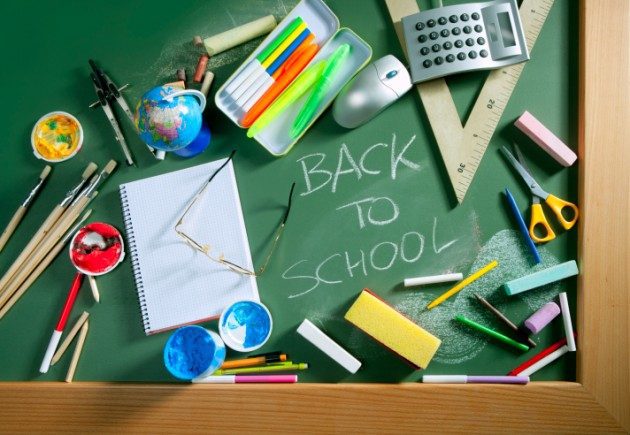Although it seems like the summer has just started, some areas of the U.S. plan to kick off the school year in about a month. As a result, retailers are preparing for adults and students who plan to hit the mall and e-Commerce sites to stock up on apparel, electronics and office supplies.
This year, the average family with children in grades K-12 plans to spend $630.36 on electronics, apparel and other school needs, down from last year’s total of $669.28, according to research from the National Retail Federation (NRF) and Prosper Insights & Analytics. For this same demographic, total spending for the season is expected to reach $24.9 billion. However, with college students included, overall sales for the season will nearly triple to $68 billion.
The decline doesn’t appear to cause major concern among NRF and Prosper officials. Looking at all potential influencers, the companies attributed the sales drop to post-recession sales spikes and decreased demand for many back-to-school products.
“We really spent 2012 to 2014 crawling out of the recession when it came to spending,” said Stacie Severs Nelson, Client Services and Marketing Director at Prosper Insights & Analytics, in a media briefing. “Spending was a little higher in those years, and consumers looked like they were replenishing items that they needed. They don’t need to purchase those items again this year, so the data isn’t just compared to last year; it’s going against those first few years out of the recession. People felt like they were able to buy that computer they really needed that they couldn’t purchase during the recession. They’re not going to need to do that again this year.”
In line with these actions, 23.6% of back-to-school shoppers said the state of the economy will not impact their spending decisions this year. This is the highest percentage of consumers the NRF has recorded for this question in the seven years it has conducted this survey.
Brick-And-Mortar Still Favorite Among Shoppers, But Online Serves Major Purpose
Although consumers have access to a wealth of channels and resources to help them check off the items on their back-to-school shopping lists, the vast majority (83%) of purchases during the season will involve physical stores, according to the International Council of Shopping Center’s (ICSC) Back-To-School Consumer Spending Survey. This total includes the 7% of consumers that plan to purchase items online and pick them up in-store at a later date. Of the shoppers who will buy online, pick-up in-store, 79% said they are likely to buy additional items once they enter a location.
It is evident that many consumers still favor brick-and-mortar, with 49% of students and 82% of parents making at least half their back-to-school purchases in-store, according to Eyeview. Conversely, only 19.6% of students and 17.7% of parents make at least half their purchases online.
However, that doesn’t mean e-Commerce is not valuable. In fact, a large percentage — 40% of students and 66% of parents — research and compare products online before even entering a store. These results prove that e-Commerce sites can help educate consumers and empower them to learn more about the items they plan to purchase.
“Shoppers are going online to comparison shop,” said Nelson. “They’re not just purchasing online; they’re also able to research what they want and find items at the lowest price.”
Retailers have stepped up their omnichannel game over the last few years and helped shoppers become smarter, whether it’s through comparison shopping online before entering a store, or price checking an item on a competitor’s site while they’re standing in that store.
As consumers research products online, they refer to product reviews and Q&As. Across popular categories such as consumer electronics and office supplies, shoppers visited reviews most frequently between July 1 and July 10, with approximately 260 million page views, according to the Bazaarvoice Conversation Index 7. The two periods prior to the peak (June 11-20 and June 21-30) gathered approximately 251 million and 255 million page views, far outperforming the two periods after the peak, which gathered less than 240 million and 225 million, respectively.
“We have a very firm belief that if you are accessing content and starting to research a purchase, you are an in market shopper,” said Matt Krebsbach, Director of Global Public And Analyst Relations at Bazaarvoice. “You are not doing that because you just enjoy reading product reviews or looking at Q&As about a laptop that you may think about buying for the school year. You are doing those things because you are interested and invested in making a purchase at some point in the near or mid-term future.”
July Marks The Official Kick-Off Of Back-To-School
It appears some consumers have started their back-to-school shopping early, with more than one third (34%) of consumers already buying items prior to July 1, according to the ICSC survey. The survey reports that 53% of back-to-school spending will occur in August and 17% will occur in September.
“If retailers aren’t already thinking about how to beef up their capabilities and attract that back-to-school shopper in early July, then they’re already behind the game,” Krebsbach said. “When we looked very specifically at back-to-school shopping in 2014, we found that research began before consumers reported that they would start that process.”
While many shoppers are embracing the early shopping season, some families are opting to wait before making a purchase in 2015. For example, 19.6% of families with children in grades K-12 will shop at least two months before school begins, down from 22.5% in 2014, according to NRF. Starting a little later this year, 42.8% say they will shop at least three weeks to one month before school, down slightly from 44.5% last year.
Staples, Target And Belk Roll Out Back-To-School Campaigns
Numerous retailers are gearing up from the back-to-school season by rolling out cutting-edge marketing programs across all channels.
For example, Staples has instituted a Lowest Price Guarantee. The retailer will take off an additional 10% of the difference between its price and a lower competitor price at time of purchase. The retailer also debuted a Shop by Grade function, enabling customers to identify items by the grade the student is entering.
Target has added a School List Assist feature to its back-to-school e-Commerce site. The new function offers a curated assortment of the most common K-8 supplies. Shoppers can then decide whether they want to pick up their item in a store or have it shipped to their home.
Belk is hosting a social back-to-school shopping campaign and offering shoppers a chance to enter a prize sweepstakes by casting their vote for a favorite fashion style during a set of themed challenges. After they submit their vote, consumers can see where their chosen look stands in the ranks after voting. Shoppers can earn sweepstakes entries by taking polls, referring friends and following the campaign on Twitter and Instagram. The contest’s grand prize winner will win a $1,500 Belk gift card. Additional weekly prize giveaways include an Apple iPad and a $50 Belk gift card.
Marketing initiatives like these are designed to capture shoppers’ attention and drive them to stores and e-Commerce sites. In fact, 74% of consumers report that they will likely start seasonal purchasing when advertisements from major retailers begin to appear, according to ICSC.
While those cues play a major role in consumers’ decisions to start back-to-school shopping, the ICSC survey found that nearly half (46%) of consumers believe they will get the best deals in August, compared to 30% in July and 15% of respondents who believe they will find the best deals Labor Day weekend or in September.
As of 2014, online conversion rates for these shoppers peaked in the second weeks of August and September, according to data from HookLogic, indicating that retailers should not ignore the power of advertising consistently throughout the season. National retailers, in particular, need to take into account the variance in school and college opening dates, which can start at any point within a five-week period from mid-August to mid-September.
“Clearly the peaks in mid-August and mid-September make a lot of sense, but before somebody purchases, they’re also researching,” said Elizabeth Jackson, CMO and EVP of Corporate Strategy at HookLogic. “The very first step before someone can purchase something is consideration. It is important from an advertising perspective to make sure products are being considered throughout the entire three-month period. Peaks are important, but valleys can give advertisers competitive advantages throughout the whole shopping journey.”













